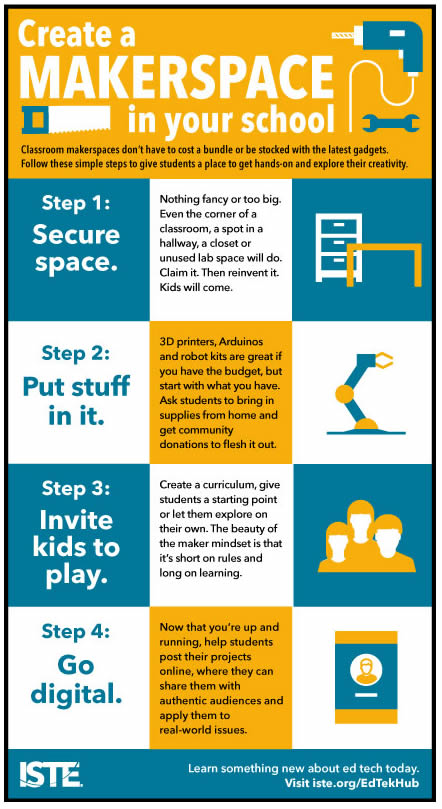FAQs about Makerspaces
What is needed to start a Makerspace in a classroom or school?
Passion - You need to have passion and a belief in the educational value of maker-style projects.
Space - This can be a whole room or only part of a room.
Supplies - Start small with simple craft materials. Often sending a message out to colleagues and the community asking for donations of materials works well.
Storage - Create a place to store materials when they are not in use and student projects as they are being worked on.
Where should the Makerspace be placed?
Makerspaces can be located just about anywhere, but there are certain spaces that make more sense in a school setting. Often, the school library is selected to start a Makerspace, as a central location for students and because of the expertise of the librarian. Another option is an unused classroom; if there is an unused woodshop, this might be an ideal space as well. If you are starting small, create a Makerspace right in your classroom.
How does a teacher justify allowing students to play when they should be focusing on academics?
Makerspaces and maker-style projects are firmly grounded in sound educational theory. The work of Papert, Piaget, Vygotsky, Dewey and many others puts the child at the center of learning, rather than the teacher. Educational theories such as constructionism, constructivism, Montessori, and the Reggio Emilia approach all support making as a way to learn.
Is a 3D printer required to have a Makerspace?
Absolutely not! 3D printers are the cutting edge, and they are a draw for students, but if you do not have one, that is not a requirement to have a Makerspace. 3D printing, a form of fabrication, is only one type of making that can happen. Computer programming, physical computing and fabrication (both digital and nondigital) are the cornerstones of making. The essential ingredients to maker-style projects are people, problems and materials. Problems are posed (by the teacher or the student), and people use materials to attempt to solve those problems.
When are students allowed to use the Makerspace?
Each educator will have to make a decision that works best for the school. This frequently depends on where the space is located, grade level of students and available staffing. Students can come during lunch, recess, before or after school, or during other free time. Students can also come with their class.
Who supervises the Makerspace?
Supervision of the Makerspace depends on where it is set up. In many schools, the librarian and support staff will supervise the space if it is in the library. Some schools have set up Makerspace supervision as a voluntary duty period, while others have staffed the Makerspace with a teaching assistant. No matter who staffs it, the key factor is for the supervisor to understand maker-style projects and have a familiarity with the materials being used by students.
Should students be required to sign up for time in the Makerspace?
This will depend on staffing, scheduling in your building, size of the space and availability of resources. If you are doing a specific project, the number of participants may be limited based on the materials available. If students are allowed to freebuild, then the number of students in the area at one time may be limited. If the space is not supervised at all times, then students may be required to sign up only during times when it is staffed.
Should students save their work?
In most cases, a single class period or after school block is not enough time to finish a project. Allow for storage of student projects if possible. As students progress in their making, there may be materials and supplies that students cannot keep (things like microcontroller boards and other technology that is not meant for one-time use), so keeping projects in the makerspace is important to ensure components are not lost.
What type of training in use of a Makerspace is recommended for students and teachers?
For teachers, sharing the educational benefit of a Makerspace is important. After that, small group training on the use and care of materials and the space is important so that the makerspace remains organized and in good shape. Consider awarding badges or certificates to participants as they complete training on different rules and materials for the space. This may also help motivate users to take pride in maintaining the space.
What is recommended to keep Makerspace items secure?
Each school has its own culture, so that decision is up to each individual. Often, more expensive materials are kept locked up and checked out to specific students when in use. Some spaces have open bins of different materials where students have free access. This may depend on the number of materials, how much funding is available to replace materials, and the type of materials.
What encourages students to use the space?
Getting students into a Makerspace can be difficult at first. It is something they are not used to doing. With a bit of advertising and word of mouth, Makerspace attendance will grow over time. It can help to get another educator involved, help co-plan an activity for students in the space, and while the students are there, remind students that they can come during their free time as well. Create flyers, use social media, make PA announcements, but the best way to get students to use a makerspace is through word of mouth. Get a few students to make something neat, then have them show it to their friends. Before you know it, the makerspace will be flooded with students who want to do it too!
Where can I find more information about implementing a Makerspace?
Register for Teaching for Creativity and Innovation: The Maker Culture and Makerspaces

